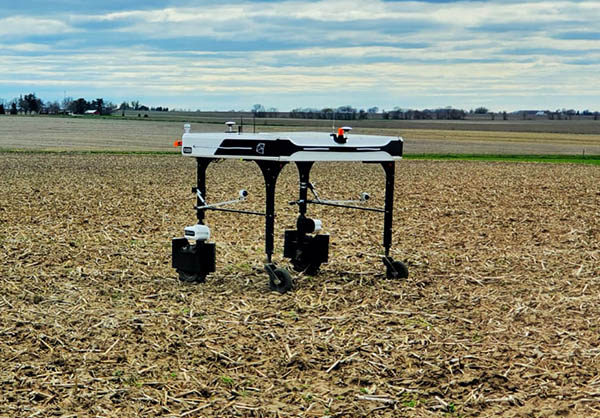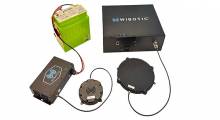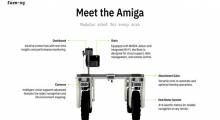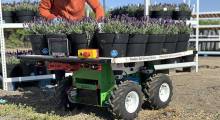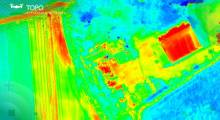Solinftec today announced that it is expanding its Solix agricultural robotics offerings. In addition to its Solix Scouting robot, the company has unveiled its Solix Sprayer robot designed to detect and spray weeds.
“Solinftec focuses on really solving structural problems in agricultural management and offers solutions that truly promote low-impact agriculture,” stated Leonardo Carvalho, director of operations at Solinftec. “Weed detection is a leading issue in fields across the North America.”
“The Solix Sprayer is designed to not only monitor and scan fields like the original scouting version, but [also to] detect and manage weeds with technology,” he added. “[It] allows the device to spot-spray into the plant instead of from above, eliminating drift and social compaction caused by larger machines and helping to lower environmental impact.”
Founded in 2007, Solinftec said customers use its technology across 22 million acres to predict upcoming conditions, solve problems, and plan. It claimed that its digital agriculture systems can generate up to 70% efficiency improvements.
The company, which raised $60 million in May and has headquarters in São Paulo, Brazil, and West Lafayette, Ind., employs more than 800 people worldwide. It will be exhibiting at the 2022 Farm Progress Show this week in Boone, Iowa.
Solix Sprayer designed for sustainability
Solinftec said it has designed its scouting and sprayer robots to help farmers reduce their chemical inputs, deliver a lower carbon footprint, and shrink their environmental impact. The Solix robots work with Solinftec’s ALICE AI platform to orchestrate machine operations and calculate producers’ ultimate needs and objectives.
ALICE AI can also recommend eco-friendly actions in real time, said the company. The system is able to coordinate fleets of multiple Solix Sprayers and Scouting robots, said Solinftec.
The new Solix Sprayer robot will provide autonomous spot-spray applications on grower’s fields, according to Solinftec. Like the Solix Scouting robot, the spray robot is powered by four solar panels that control the drive system and the spray system.
The robot can collect data and report on crop populations, weed identification and densities, and disease identification and thresholds. In addition, it can help monitor insect identification and thresholds, nutrient deficiency identification and densities, and normalized difference vegetation index (NDVI).
Solinftec said its robots can provide layers of maps for data analysis and more useful data to the grower virtually 24/7. The Solix spray robot will provide weed spot-spray maps with analysis on inputs saved.
It can service up to 96 acres per day, depending on the field shape and terrain, said the company. The robots serve grain crops, such as corn, soybeans, cotton, and wheat.
Autonomous agriculture advances
How does the Solix Spayer compare with conventional sprayers?
“Solix Sprayer is 40 ft. in size, end-to-end, and it can manage between 300 and 500 acres per week,” replied Henrique Nomura, chief technology officer at Solinftec. “Once a week, the robot returns to the starting point to treat weed growth with 24/7 autonomy.”
Nomura cited the following benefits to Robotics 24/7 in comparison with conventional sprayers:
- The Solix spray robot optimizes chemical use in pre-planting, post-planting, and post-harvesting applications of herbicides. The Solix spray and scouting robots will provide extensive data and take advantage of their movement in the field for scouting.
- Artificial intelligence provides full autonomy.
- The new robot scans the plant, from root to leaf.
- It promotes the rational use of agrichemicals.
- Solix Sprayer can ensure soil health.
- Solinftec said its new system enables low-carbon agriculture.
Solix Sprayer and Scouting use the same unique platform, he noted. “Each one has several sensors meeting different needs of countries, regions, and cultures,” said Nomura.
Solinftec partners with McKinney Corp.
Solinftec has partnered with research, development, and manufacturing company McKinney Corp., which will produce the Solix Sprayer. The companies said the mobile robot will be commercially available in 2023 to the entire agricultural market, including farmers, cooperatives, and ag-retailers.
Nomura said McKinney “is helping us with inputs and mechanical insights, making the structure and entire robot assembly are constantly improved. They will be responsible for the first pre-manufacturing series and future improvements.”
“Solinftec’s partnership with McKinney Corp. will positively impact our ability to market and deliver Solix Ag Robotics by consolidating Solix's scalability and accelerating service to the North American markets,” said Carvalho. “It also supports Solinftec's goal of making this technology available globally.”
Farming robot pilots under way
Pilots for the Solix models are currently running in North America with the GROWMARK agricultural cooperative in Bloomington, Ill.; Purdue University in Indiana; and Stone Farms Inc. and the University of Saskatchewan in Saskatoon, Saskatchewan.
In Brazil, electronics manufacturing and service company Hi-Mix Eletrônicos S/A produces the Solix Scouting robot. It has been commercially available there since last April.
“Since the beginning, we have identified a strong culture in Solinftec to the agriculture market, investing heavily in R&D, plus a determination for quality, flexibility, and agility for the best time to market,” said Daniel Carvalho, co-founder Hi-Mix Eletrônicos.
“The pilots we carried out in Brazil, focused on pests—insects,” said Nomura. “[They] showed a great identification of insect models with a very large reduction in the application of chemical products.”
“In the U.S., we had a weed identification with a reduction of up to 70% in herbicide use,” he noted. “In Canada, with the Scouting model, we identified several types of weeds and had good feedback from customers regarding pest identification, herbicide application, and monitoring of the evolution of the crop stage.”
About the Author
Follow Robotics 24/7 on Linkedin
Article topics
Email Sign Up

